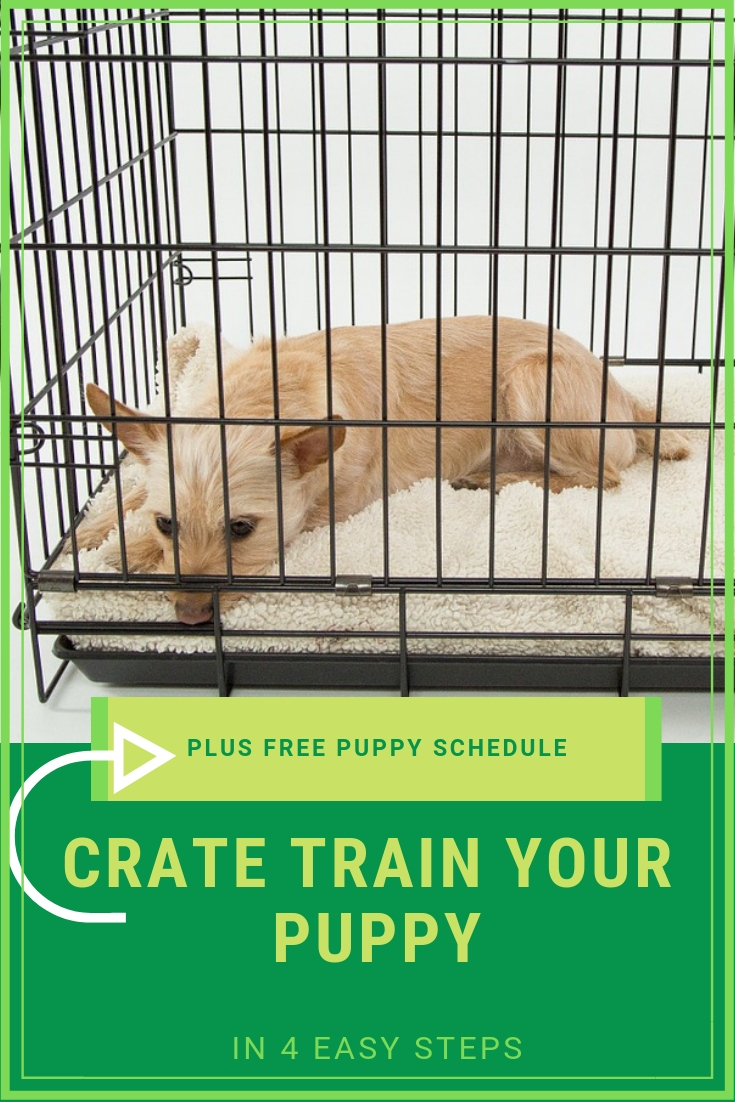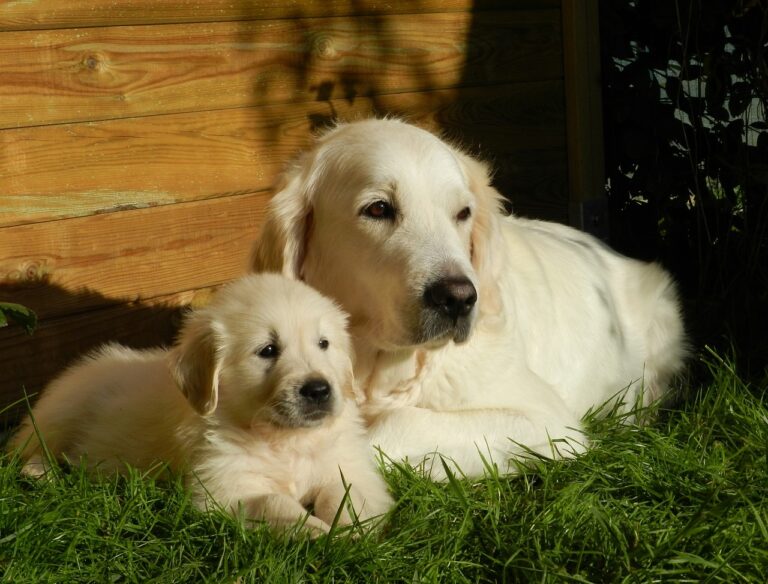{This post may contain affiliate links. This means we may make a small commission at no extra cost to you. This website is a participant in the Amazon Services LLC Associates Program. As an Amazon Associate we earn from qualifying purchases. We only recommend products that we believe will be of value to our followers. Click HERE to see our disclosure for details.}

A popular and very successful way to house train a puppy is by using a crate. A puppy who was raised in a clean environment does not want to relieve themselves in the area where they sleep. Although a crate is a useful tool for training your puppy or dog, it has to be done properly in order to work. There are some rules we recommend to follow when you are crate training a puppy.
Crate Training Rules:
1. Never Use The Crate As A Form Of Punishment
You want the crate to be a positive place for your puppy. A place where he feels content and safe. If you start using the crate as a form of punishment, your puppy may develop a negative association with the crate. Once this happens he may not be happy to go in his crate any longer.
2. Do Not Leave A Puppy Crated For Longer Than They Can Handle
Puppies cannot hold their bladders for long periods of time. For a young puppy, 3 to 4 hours should be the maximum amount of time that they are left in a crate without a potty break. If you work full time, you will need to make arrangements with someone to let your puppy out for a pee break every 3 to 4 hours.
3. Do Not Crate Your Puppy Or Dog Too Long Each Day
Whether you are crating a puppy or an older dog, they should not be crated all day and all night with only a few potty breaks. Puppies and dogs both need lots of exercise and time spent with their family in order to be happy. If your schedule is so busy that you do not have time to properly exercise and spend time with a dog, then do not get a puppy.
Types Of Crates:
There are several types and styles of crates to choose from. The three main types are plastic, wire and fabric. Each type has it pros and cons and the type that you choose will depend on how you plan on using your crate.
Plastic Crates
Plastic crates are a great option if you are going to do a lot of traveling with your dog as they are more secure than a typical wire crate or fabric crate in a vehicle. If you plan on flying with your dog, many of the plastic crates are airline approved, they should have this listed on the crate’s product tag.
They are also a great option for in your home too. Dogs like the privacy of the plastic sides, it’s like their own little cave. The plastic sides help to prevent your dog from being able to pull things in that are laying outside of his crate.
Wire Crates
Wire dog crates are perfect if you plan on taking your puppy places where he will need to be crated. They easily fold up and are easy to transport. They have the best ventilation of all three choices. This type of wire crate is not the best option for your puppy to travel in inside a vehicle, the wire can easily bend, break and hurt the dog in the case of an accident. There are special heavy duty wire crates that are built for use in vehicles that are tough and crash tested though.
Fabric Crates
A fabric crate is not recommended to use to crate train your puppy. Fabric crates are easy for dogs to escape from as they can rip the mesh sides or door. They are great for dogs that are used to being in a crate as they are so convenient to fold up and take with you. However, your dog should be closely supervised in a fabric crate. Supervise him until you know for sure that you can trust him not to rip open the mesh.
Steps for Crate Training Your Puppy:
Some breeders or rescues may already have started the process of crate training your puppy. If they have, that’s a bonus for you! Check with your breeder or rescue to see if your puppy was introduced to a crate. If he was, these steps will be much easier for you.
If you are starting from scratch, it can take several days or weeks to crate train your dog. It all depends on your dog and how receptive they are to the crate.
Step 1: Introduce Your Puppy To The Crate
Place the crate in a room where your family spends a lot of time. Have the crate door open so that the puppy can go inside and explore. Puppies are usually quite curious and will go inside to check things out. If your puppy goes in the crate on his own, give him a treat while he is in there.
If your puppy is nervous of the crate or not interested, toss a few really good smelling treats in the crate. Give him some time to investigate. If he still won’t go in the crate, make a trail of high value treats leading in to the crate. If treats just aren’t his thing, try placing his favorite toy in the crate. Make sure that he sees you putting the toy in there so that he wants to go and get it.
Step 2: Make The Crate A Great Place To Be
Your puppy needs to feel that the crate is a positive place to be. In order to do this, he needs to associate it with the things that he really likes. At meal time, you can place his food in his crate. Place it in the back of his crate so he has to go the whole way in to eat it. If he’s not to the point yet that he is comfortable with his crate, place his food bowl closer to the door of the crate so that he doesn’t have to go the whole way in to eat. Gradually place the food bowl back further in the crate until your puppy has to go inside of the crate to eat.
Place a nice snuggly blanket in the crate. Although, we do recommend not leaving a blanket in his crate while he is unsupervised. Make sure that you know that your puppy will not chew up and eat a blanket or bed before leaving one in his crate. Make his crate a cozy place to be.
Have some of his favorite toys in his crate. Toys also should not be left in the crate with your puppy unsupervised. Make sure that any toy that you leave with your puppy is durable and not a choking hazard.
Step 3: Gradually Increase The Amount Of Time In The Crate
Once your puppy becomes used to the crate, gradually, start closing the door while he is eating. As soon as he is finished eating open the door again so he can come out if he would like to. Each meal time increase the amount of time that you keep the door closed. If he starts whining, you may have increased the time too quickly. Next time do not leave the door closed for quite so long. And gradually work your way up to longer amounts of time. If he whines, do not let him out of the crate until he is quiet. Letting him out of his crate while he is whining is teaching him that if he whines, he gets the door opened to come out.
Step 4: Crate Overnight And For Short Periods Through The Day
Once your puppy is able to spend at least 30 minutes in his crate without getting upset, you can leave him in his crate while you leave the house. Do not leave for a long time, no longer than an hour the first time. If all goes smoothly, you can try letting him sleep in his crate overnight. Of course, you will most likely have to get up through the night with him for a potty break. As your puppy gets older he should start sleeping through the night without a potty break.
At this point, you should also be able to crate your puppy while you are gone to work. But make arrangements so that he can go out for a potty break every 3 to 4 hours. You do not want to leave your puppy in his crate too long or he may have an accident.
Of course, some puppies will be very easy to crate train and others will take more time and patience. If you have a puppy that has been traumatized regarding crates or did not have the best start to life, crate training could be more challenging. If you have an extreme case and these steps do not work with your puppy, seek out a professional dog behaviorist in your area that can access and help with your situation.





